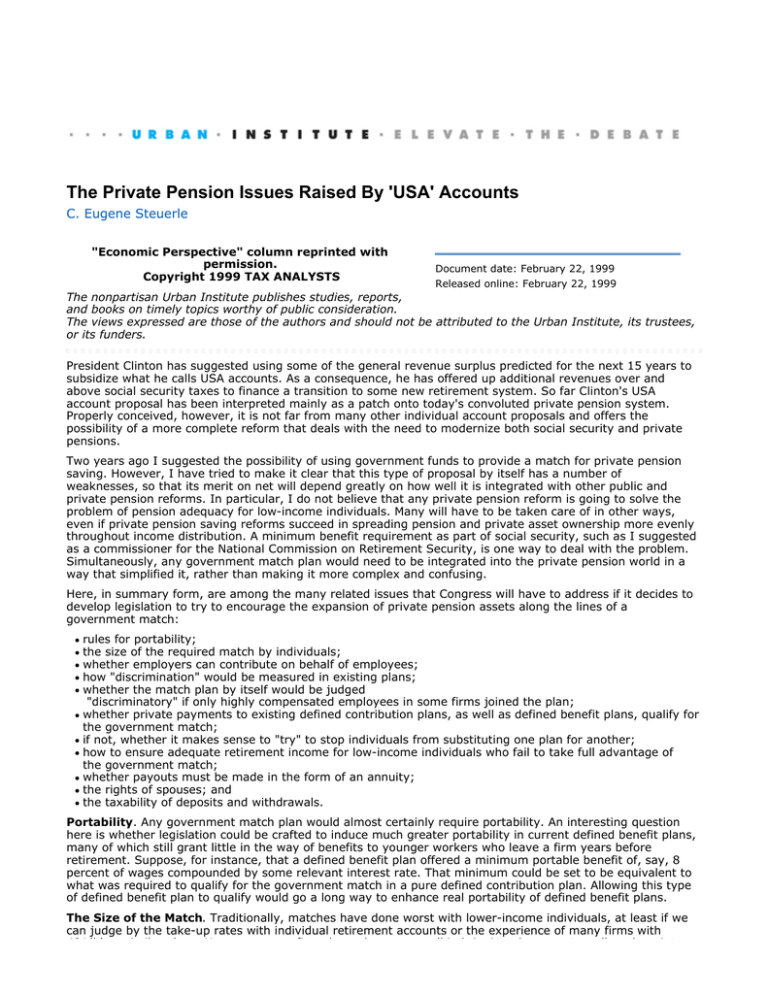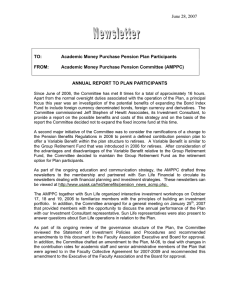The Private Pension Issues Raised By 'USA' Accounts C. Eugene Steuerle
advertisement

The Private Pension Issues Raised By 'USA' Accounts C. Eugene Steuerle "Economic Perspective" column reprinted with permission. Copyright 1999 TAX ANALYSTS Document date: February 22, 1999 Released online: February 22, 1999 The nonpartisan Urban Institute publishes studies, reports, and books on timely topics worthy of public consideration. The views expressed are those of the authors and should not be attributed to the Urban Institute, its trustees, or its funders. President Clinton has suggested using some of the general revenue surplus predicted for the next 15 years to subsidize what he calls USA accounts. As a consequence, he has offered up additional revenues over and above social security taxes to finance a transition to some new retirement system. So far Clinton's USA account proposal has been interpreted mainly as a patch onto today's convoluted private pension system. Properly conceived, however, it is not far from many other individual account proposals and offers the possibility of a more complete reform that deals with the need to modernize both social security and private pensions. Two years ago I suggested the possibility of using government funds to provide a match for private pension saving. However, I have tried to make it clear that this type of proposal by itself has a number of weaknesses, so that its merit on net will depend greatly on how well it is integrated with other public and private pension reforms. In particular, I do not believe that any private pension reform is going to solve the problem of pension adequacy for low-income individuals. Many will have to be taken care of in other ways, even if private pension saving reforms succeed in spreading pension and private asset ownership more evenly throughout income distribution. A minimum benefit requirement as part of social security, such as I suggested as a commissioner for the National Commission on Retirement Security, is one way to deal with the problem. Simultaneously, any government match plan would need to be integrated into the private pension world in a way that simplified it, rather than making it more complex and confusing. Here, in summary form, are among the many related issues that Congress will have to address if it decides to develop legislation to try to encourage the expansion of private pension assets along the lines of a government match: rules for portability; the size of the required match by individuals; whether employers can contribute on behalf of employees; how "discrimination" would be measured in existing plans; whether the match plan by itself would be judged "discriminatory" if only highly compensated employees in some firms joined the plan; whether private payments to existing defined contribution plans, as well as defined benefit plans, qualify for the government match; if not, whether it makes sense to "try" to stop individuals from substituting one plan for another; how to ensure adequate retirement income for low-income individuals who fail to take full advantage of the government match; whether payouts must be made in the form of an annuity; the rights of spouses; and the taxability of deposits and withdrawals. Portability. Any government match plan would almost certainly require portability. An interesting question here is whether legislation could be crafted to induce much greater portability in current defined benefit plans, many of which still grant little in the way of benefits to younger workers who leave a firm years before retirement. Suppose, for instance, that a defined benefit plan offered a minimum portable benefit of, say, 8 percent of wages compounded by some relevant interest rate. That minimum could be set to be equivalent to what was required to qualify for the government match in a pure defined contribution plan. Allowing this type of defined benefit plan to qualify would go a long way to enhance real portability of defined benefit plans. The Size of the Match. Traditionally, matches have done worst with lower-income individuals, at least if we can judge by the take-up rates with individual retirement accounts or the experience of many firms with 401(k) or similar plans. However, some firms have done very well in bringing along most or all workers into 401(k) or similar plans. However, some firms have done very well in bringing along most or all workers into their defined contribution plans. My guess is that large firms would have substantial incentives to try to ensure that government matching money did not pass their employees by. Employer or Employee Contributions. Along the same lines, I would strongly recommend that employer contributions on behalf of the employee qualify for the government match as well as employee contributions. Indeed, where possible legally, I would allow firms essentially to mandate participation, either by making contributions for all employees, or by withdrawing the appropriate amount of money from the employees' pay under some contractual agreement. Getting the support of employers stands the greatest chance of ensuring that the money gets to lower-income workers, who are the ones who would most often opt out of any government match. Discrimination Rules. The government match proposal all but begs for a reconsideration and simplification of pension discrimination rules. Obviously, the amount of money put into any special USA account should be related to the overall structure of all pension plans in a firm. And despite my general call for greater simplification, I am skeptical that the match can proceed without any discrimination rule at all. After all, it is just as possible for a government match to be used mainly by highly compensated employees as are some other tax subsidies under existing pension rules. I have suggested that the government match be made available to workers as individuals independently of what their firm does, but for employees above some income level, the match could only be provided through employer plans that include most or all employees. Existing Plans. I believe that it will be impossible over time to avoid substitution from one plan to another. My guess, however, is that President Clinton and Congress will attempt to develop some eventually unenforceable rule that would make the USA accounts only an add-on to every other plan that is out there. My own bias would be to try to better integrate any new plan with the existing pension system. We really don't need a 27th set of rules for yet another special type of retirement or saving incentive. As noted, I would also allow combination defined contribution/defined benefit plans to qualify as long as the matched contributions were made portable and significant for younger employees who leave a firm. Securing the Retirement Income of Low-Income Individuals. With a voluntary plan, many low- and moderate-income individuals will simply fall through the cracks one way or the other. This is not necessarily a criticism if broader reform is undertaken. If a government match helps move the ownership of private pension assets more into the middle-class and provides less concentration among the top 30 percent of workers, it would still be a positive development. What this means, however, is that the basis or minimum benefit in social security needs to be made as secure or even better than under current law. The National Commission on Retirement Policy backed my proposal for just such a basic benefit, although that commission also favored a small mandated individual retirement account rather than a voluntary USA account. In a voluntary setting, the need for a decent social security minimum is even greater than with a mandated individual account. Annuities. Many of the problems of the social insurance system stem from individuals retiring fairly young on a moderate pension that becomes quite inadequate in later years, especially for those who are widowed or single. Required conversion to a lifetime annuity is probably necessary under those circumstances, although one could grant something like a 15-year guarantee for the families of a worker-beneficiary who only lives a short time into retirement. Spouses' Rights. Generally speaking, I believe that monies put into accounts should be shared equally with spouses at time of deposit. On divorce or separation, each spouse would be entitled to his or her own share, except where a divorce decree ruled otherwise. Social security itself cannot yet handle this type of sharing requirement. Taxability. The standard pension rule is still the best: deduction on deposit, taxation on withdrawal. That treatment equalizes tax rates best over a lifetime and avoids creating much larger budgetary losses in later years that are hidden up front. In sum, there are a great many drafting decisions to be made before USA accounts can be made to work well. Their success or failure depends not merely on how they integrate with social security, but with private pensions as well. Other Publications by the Authors C. Eugene Steuerle Usage and reprints: Most publications may be downloaded free of charge from the web site and may be used and copies made for research, academic, policy or other non-commercial purposes. Proper attribution is required. Posting UI research papers on other websites is permitted subject to prior approval from the Urban Institute—contact publicaffairs@urban.org. If you are unable to access or print the PDF document please contact us or call the Publications Office at (202) 261-5687. Disclaimer: The nonpartisan Urban Institute publishes studies, reports, and books on timely topics worthy of public consideration. The views expressed are those of the authors and should not be attributed to the Urban Institute, its trustees, or its funders. Copyright of the written materials contained within the Urban Institute website is owned or controlled by the Urban Institute. Source: The Urban Institute, © 2012 | http://www.urban.org

